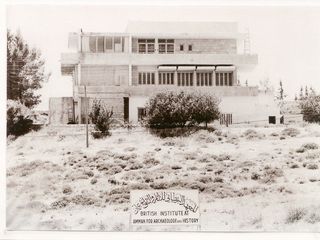
In 2019, CBRL marked the centenary of its founding institute, the British School of Archaeology in Jerusalem (BSAJ). Over one hundred years later, CBRL operates as a UK charity to produce and disseminate original, rigorous independent scholarship in the humanities and social sciences and facilitate UK-Levantine academic collaborations, partnerships and knowledge exchange.
CBRL was established in 1998, incorporating the BSAJ and the British Institute at Amman for Archaeology and History (BIAAH). The two institutes continue today as the CBRL Kenyon Institute in Jerusalem (renamed in 2001) and the CBRL Amman Institute in Jordan. CBRL is one of the British International Research Institutes (BIRI) with an office at the British Academy.
The BSAJ
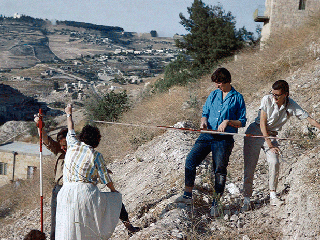
The BSAJ was founded in 1919. Robert Mond, a British chemist and archaeologist who did archaeological work in Ancient Egypt and Palestine, and who was involved with the preservation of the tomb of Ramesses I, was instrumental in its foundation. Mond became the BSAJ’s first treasurer following the establishment of the British Mandate in Palestine. Kathleen Kenyon’s father, Sir Frederic Kenyon, was also prominent in founding the BSAJ through his involvement with the Palestine Exploration Fund and while acting as President of the British Academy (1917-1921). Kenyon was appointed President of BSAJ in 1920. The BSAJ’s first director was Professor John Garstang, and its UK offices were at the Palestine Exploration Fund in London.
The BSAJ was initially intended as a training ground for the Palestine Department of Antiquities. Following a process of familiarisation and survey in Palestine by its staff, the first excavations were undertaken at Harbaj, Amr and Kussis in 1922. The assistant director of the school, W.J. Phythian-Adams, also directed the Palestine Exploration Fund’s excavations at ‘Askalan (Ashkelon) and was responsible for the organisation of the Palestine Museum. By 1924 the BSAJ was running classes in excavation training and seminars on excavation method, which were attended by representatives of the American School and the Ecole Biblique, with whom there existed close relations.
By 1923 the work of the BSAJ was extended to Dor on the Mediterranean coast, and to Amman in Transjordan. During this time, the library was greatly improved by the gift of books donated by Phythian-Adams, with the BSAJ also benefitting from the financial support of Robert Mond. In 1924, K.A.C. Creswell’s work on the Dome of the Rock in Jerusalem was published by the BSAJ. Also in 1924, George Horsfield began work at the Amman citadel and the following year at Jarash; John Crowfoot also excavated at Jarash between 1928 and 1930. Robert Hamilton, who joined the Department of Antiquities in 1931 and became its director in 1938, first came to Palestine under the aegis of the BSAJ and participated in Crowfoot’s excavations at Jarash. Crowfoot went on to direct the Joint Expedition to Samaria from 1931 to 1935. In 1952, after the hiatus of World War II, Kathleen Kenyon re-established the BSAJ as an educational charity in receipt of grant aid from the British Academy, and it was the principal sponsor of her excavations at Jericho (1952 to 1958).
In 1957, Kenyon established the BSAJ in the Husseini Building in East Jerusalem, and during the summer, it was the base for her major excavations in Jerusalem (1961 to 1967). In 1967, the BSAJ moved to the Kenyon Institute’s current premises in Sheikh Jarrah, the British Consul’s former home in East Jerusalem. In 1968, the BSAJ began a major project to survey the surviving Mamluk buildings in Jerusalem, which was later continued by surveys of Ottoman Jerusalem and Crusader and Islamic Palestine.
The BSAJ had always sponsored projects elsewhere in the region, but this became increasingly difficult after 1967. In 1968, two truckloads of excavation and camp equipment were moved from the BSAJ east of the Jordan River, and in 1975 Crystal-M. Bennett, the director of the BSAJ, set up the (as yet unofficial) British Institute of Archaeology in Amman. Bennett remained the director of the BSAJ as well as directing the Amman Institute and, with the permission of the British Academy, divided her time between the two. In 1978, the British Academy first provided grant-in-aid for the institute in Amman. Bennett, who had retired from the BSAJ, became its full-time director.
Twenty years later, following a review of its research centres abroad in 1998, the British Academy decided that the division of British research into areas covered by the BSAJ and the BIAAH should be brought back together under a single body: the Council for British Research in the Levant (CBRL).
The BIAAH and Crystal-M. Bennett
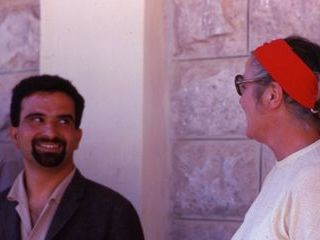
The BIAAH began in the 1970s as an archaeological field station for visiting researchers. It was founded by archaeologist Crystal-M. Bennett and was originally located in a house overlooking the University of Jordan’s main gates in Amman. It was registered as one of the British Academy’s sponsored institutes in 1978.
Following fieldwork in the UK, Crystal-M. Bennett joined Kathleen Kenyon’s excavations at Jericho for the 1957 to 1958 season, then worked with Peter Parr at Petra before commencing what was to become the principal archaeological project of her career, the study of Edomite settlement in modern south Jordan. Her first season of work was at Umm al-Biyara in Petra in November 1960.
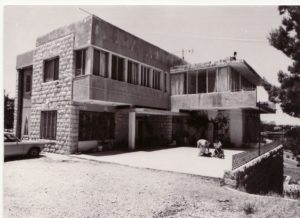
Bennett worked for three seasons at Umm al-Biyara (1960, 1963, 1965); four seasons at Tawilan above Wadi Musa (1968-1970, 1982) and for five seasons at Busaira (1971-74, 1980), discovering settlements which she dated mainly from the late eighth and seventh centuries BC. She provided the first rigorous archaeological framework for the study of southern Jordan during the Iron Age.
Bennett was appointed secretary-librarian of the BSAJ (1963 to 1965), its director in 1970 and in the following years established an archaeological base in Amman, which she also managed. She played a critical role in Jordan in establishing the BIAAH in 1975. In the same year, she undertook the Department of Antiquities’ excavations on the citadel of Amman.
Dame Kathleen Kenyon
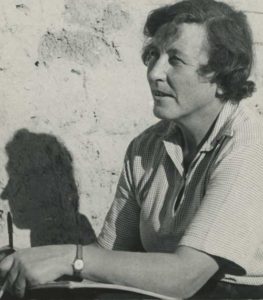
Kathleen Mary Kenyon was born in London on 5 January 1906, the elder daughter of Sir Frederic Kenyon, the British Museum director. She was educated at St Paul’s Girls School in London, and at Somerville College, Oxford, where she read Modern History and became the first woman president of the Oxford Archaeological Society in Michaelmas Term, 1927. Throughout her life, she served on countless other archaeological committees. Her first real venture into field archaeology was to Zimbabwe with Miss G. Caton-Thompson in 1929. Thereafter her career was almost entirely in archaeology, initially working with the Wheelers at Verulamium in the UK.
During the 1930s and 1940s, she participated in or directed five excavations in England and played an important role in the Crowfoot excavations at Samaria in Palestine (1931 to 1934). During World War II, she worked for the Red Cross in London, in 1942 becoming Director of the Youth Department, where she ran a highly successful recruitment campaign. From 1935 to 1948, she was Secretary at the Institute of Archaeology in London (Acting-Director 1942-1946). She was a lecturer at the institute from 1948 to 1962.
After the war, she directed excavations first at Sabratha in North Africa (1948 to 1949), and then from 1952 to 1958 at Jericho in Palestine, followed from 1961 to 1967 by her excavations at Jerusalem. The work at Jericho was ground-breaking at the time and made world headlines, especially for the discovery of the Neolithic tower and walls, and the details unearthed of the Mesolithic and Neolithic inhabitants.
At the same time that she began work at Jericho, in 1952 she re-founded the BSAJ which had lapsed since before World War II. She served as its first director from 1956 to 1965 and became its chairman in 1968, a role she fulfilled until her death.
In 1962, she was appointed Principal of St Hugh’s College, Oxford until her retirement in 1973. One of the college buildings is named in her memory. She continued her work on publication and committees until her death on 24 August 1978 at the age of 72. The five volumes of final reports on Jericho were almost complete at the time, and the long list of her publications is given in the Festschrift published in her honour in 1978.
Further reading
Auld, A. G. (1993) The British School of Archaeology in Jerusalem, pp. 23-26 in A. Biran and J. Aviram (eds) Biblical Archaeology Today, 1990. Proceedings of the Second International Congress on Biblical Archaeology, Jerusalem.
Balderstone, S. Crystal-M. Bennett Online Biography
Davis, M.C. (2008) Dame Kathleen Kenyon: Digging Up the Holy Land. Walnut Creek, CA: Left Coast Press.
Davies, G.I. (1988) British Archaeologists, pp. 37-62 in J.F. Drinkard, G.L. Mattingly and J.M. Miller (eds) Benchmarks in Time and Culture: An Introduction to Palestinian Archaeology, Atlanta.
Dever, W.G. (2004) ‘Kathleen Kenyon (1906–1978)’. In: Cohen, G.M. and Joukowsky, M.S. (eds.) Breaking Ground: Pioneering Women Archaeologists, pp. 525–553. Ann Arbor: University of Michigan Press.
Gibson, S. (1999) ‘British Archaeological Institutions in Mandatory Palestine, 1917-1948’, Palestine Exploration Quarterly, 131, 115-143.
Moorey, P.R.S. and Parr, P. (1978) Archaeology in the Levant: Essays for Kathleen Kenyon, Aris & Phillips.
Prag, K. (2010) Crystal-M. Bennett OBE, BA, D.LITT., FSA: A Memoir. PEQ 142, 43-63.
Talbot, G. (1987) Crystal-M. Bennett, O.B.E. D.Litt., FSA. An Appreciation. Levant, 19, 1-2.
Tushingham, A.D. (1985) Excavations in Jerusalem 1961-67. Vol. 1. Report on the Joint Expedition. British School of Archaeology in Jerusalem; The Royal Ontario Museum; École Biblique et Archéologique Française, Jérusalem. Toronto: Royal Ontario Museum.











